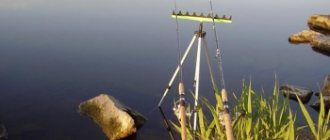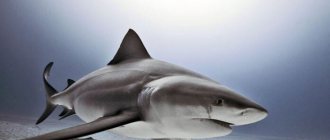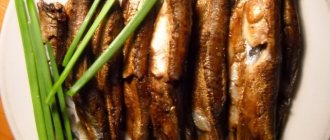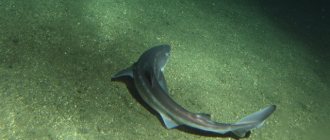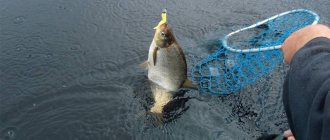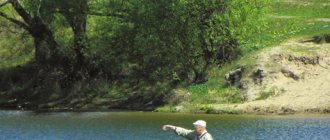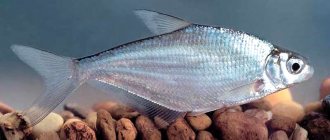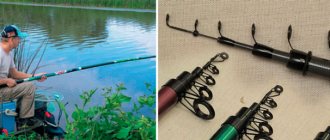There are a large number of rivers and reservoirs on the territory of Russia. This provides truly inexhaustible opportunities for successful and exciting fishing. Freshwater bottom fish is a healthy and nutritious product that contains essential animal proteins, amino acids and valuable microelements. The diversity of river fauna and flora allows fishing enthusiasts to get vivid, unforgettable experiences, enjoying many different fishing methods.
Bottom fish that live in our country have behavioral and characteristic features. Let's look at some types of bottom fish that are found in Russian water bodies.
Perch
Perch is one of the most common fish living in domestic reservoirs. It lives in clean, oxygenated water and prefers a rocky or sandy bottom. Perch fishing is available all year round. Experienced fishermen know that perch bites more readily in the morning and evening hours. As bait, it prefers bloodworms, worms, and fry.
What does flounder look like and where is it found?
Flounder is a marine ray-finned bottom fish with an asymmetrical flat body of a leaf-oval or rhombic shape. A characteristic feature is the location of the eyes on one side. The bottom side is pale and has a rough roughness. The eye side is olive-brown, with orange-yellow spots. Its skin is smooth with small scales. Flounder reaches an average length of 35-40 cm after 5 years; older individuals grow up to 1 meter. Can live up to 50 years.
In total there are about 500 varieties of this fish. In the seas washing the shores of Russia there are about 30. The flounder family includes: yellowfin, white-bellied, halibut species, as well as limanda, ruff flounder, and halibut.
Flounder is caught in the Atlantic, White, Okhotsk, Kara, and Baltic seas. Yellow-bellied flounder is found off the western coast of Kamchatka. The Black Sea variety is called kalkan. River flounder, glossa, is also found in nature.
Zander
It is a cousin of the perch. Prefers to live in deep-sea reservoirs with a rocky bottom, where shelter can be easily found. Every angler dreams of getting a trophy in the form of a pike perch, whose maximum weight is close to twenty kilograms! On average, the weight of pike perch varies from three to five kilograms. Pike perch bite all year round, but are more likely to bite in the cold season, at dawn. That is why it is more advisable to hunt pike perch in winter, when the ice has become strong. Artificial baits - spinners, wobblers - are actively used as bait.
Pike perch loves to eat fry or pieces of fish.
Ancistrus content
Most often, these aquarium inhabitants are active at dusk and during the day, in case of a drop in atmospheric pressure. Ancistrus loves clean, oxygen-enriched water, with a temperature of 22-24 degrees and a hardness of up to 30 degrees. The life expectancy of representatives of this species averages from 5 to 8 years, puberty occurs at the age of one year. Ancistrus feeds mainly on plant foods, but it is necessary to place driftwood in the aquarium to facilitate their digestion.
It is worth knowing that this fish likes to get inside the filter, which can lead to its death. That is why special attention should be paid to this nuance. The species gets along well with other aquatic inhabitants, but males can start fights among themselves. Therefore, it is better to keep such a sexually mature individual separately. Water replacement, filtration and aeration are necessary.
These bottom-based aquarium fish are very useful due to the peculiarity of their mouth with suction cups. It allows them to clean the walls of the aquarium by scraping off algae and plants. That is why the species is popularly called “sticky catfish” or “sucker catfish.”
Som
Catfish is the largest and strongest representative of bottom fish living in Russia. It is found in deep reservoirs with muddy and dirty water. It prefers a rocky bottom, dotted with various types of natural shelters: snags, holes, pools. To successfully catch catfish, larger baits are used. He loves to eat frogs, fried sparrows, crayfish, and pieces of fish. Unlike its counterparts, catfish actively bite in rainy and hot weather.
Types of bottom fish[edit | edit code]
Bottom-dwelling fish can be divided into two main types: purely bottom-dwelling (benthal) and benthopelagic, which rise above the bottom and swim in the water column. Benthopelagic fish have neutral buoyancy, which allows them to swim effortlessly, while bottom-dwelling fish have a denser body and negative buoyancy, which keeps them at the bottom without expending energy[7]. There are more benthopelagic fish than purely bottom-dwelling fish[1]. In addition to the flattened body shape, an adaptive feature of the structure of many bottom-dwelling fish is the lower mouth, which allows them to feed from the ground. Sand sucked in with food is usually expelled through the gill slits. However, stargazers have an upper mouth and upward-pointing eyes because they hunt prey floating in the water column.
Painting by Jan van Kessel (the elder) depicting demersal and bentho-pelagic fish (flounder and cod)
Bottom and demersal fish[edit | edit code]
These fish have a dense body and negative buoyancy. They spend their entire lives on the bottom[6]. They can be divided into 4 groups. Representatives of the first group (watchers-pursuers) wait for prey and attack, making a rapid dash, like a pike. They have an arrow-shaped body, well-developed dorsal, anal and caudal fins. They lead a solitary lifestyle in a limited individual habitat. The second group includes ambushers with a flat body, large mouth and camouflage coloration. Sometimes they have special outgrowths on their body that serve as bait. These are diamondback stingrays, large flounders, common catfish, and monkfish. The third group is benthic melilots with a flat (most stingrays, anglerfish, many flounders, chimeras) or worm-like body (eels, loaches). They lead a solitary lifestyle. The fourth group includes schooling benthic eaters (carp and many other cyprinids) that migrate[8].
Examples of fish that can burrow into the ground are flounder and stingrays. Flounders are a group of ray-finned fish that lead a bottom-dwelling lifestyle, lie and swim on their sides. They do not have a swim bladder. The eyes are shifted to one side of the body. Flounder larvae initially swim in the water column; as they develop, their body transforms, adapting to life on the bottom[9]. In some species, both eyes are located on the left side of the body (arnoglossa), while in others - on the right (halibut).
Ipnopoids, which also live at the bottom, look completely different. They usually stand motionless, supported by long and thickened marginal rays of the ventral fins and tail (sometimes called tripod fish). They ambush planktonic crustaceans. The long rays of the pectoral fins function like sensitive antennae, since the eyes of these fish are poorly developed[10].
- Batipters[en] Bathypterois grallator
“stand” on the bottom, leaning on the long rays of their fins[11]
- Scat Taeniura meyeni
hunts bottom fish, bivalves, crabs and shrimp[12]
| Body types of bottom fish | |
| The body is elongated, the head is flattened, the back is arched, the pectoral fins are enlarged. Examples: catfish, chain catfish with a large terminal mouth, small armored catfish with a small lower mouth, and sturgeon with fleshy, mobile lips located on the underside of the snout[13] | |
| Small fish with a flat head, large pectoral fins and a mechanism, usually modified pelvic fins, that allows them to attach to the bottom. Such structures help fish stay in place in fast currents or tidal areas with strong currents. The simplest mechanism exists in slingshot-like fish, which use their small, closely spaced pelvic fins as an anti-sliding device. However, in other fish, such as suckers and gobies, they have turned into suckers[13]. | |
| They differ from the previous type in the absence of a suction cup. They have a more elongated body and a small head. Such fish usually live under rocks and in crevices in calm waters. These are blennies and peppers that live in the streams of North America[13]. | |
| Flounders have the most unusual morphology among bottom-dwelling fish. They have a flat, asymmetrically laterally compressed body and no swim bladder. Both eyes are shifted to one side of the body. The mouth is usually shifted to the lower, blind side. In stingrays, on the contrary, the body is compressed in the dorsoventral plane; in most, the large pectoral fins form a disc. On the ventral side of the body there are the mouth, nostrils and gills, and on the dorsal side there are the eyes and spleen [13]. | |
| Fish like grenadiers have a large head and a high body in the front, which tapers strongly towards the tail. These are inhabitants of deep waters. They feed on carrion or bottom invertebrates. Examples of this type are chimeras, long-tailed and bitite[13]. | |
Ecological zones of the world's oceans The small-eyed grenadier is a bottom-dwelling fish with an elongated body, large eyes and a well-developed lateral line.
Benthopelagic fish[edit | edit code]
Atlantic roughy
Benthopelagic or demersal fish live in close proximity to the bottom, feeding on benthos and benthopelagic zooplankton[14]. Most demersal fish are benthopelagic[1]. They can be divided into types with a strong body and flabby ones. Flabby benthopelagic species are similar to bathypelagic species, they have a small body mass and a low metabolic rate. They expend minimal energy and hunt from ambush[15]. An example of this type is Acanthonus armatus.
[16], a predator with a large head and a body that is 90% water.
These fish have the largest otoliths and the smallest brain relative to body size among vertebrates[17]. Patagonian toothfish
Hard-bodied benthopelagic fish are active swimmers that vigorously search for prey on the bottom. Sometimes they live around underwater peaks with strong currents[17]. Examples of this type are the Patagonian toothfish and the Atlantic roughy. Previously, these fish were found in abundance and were a valuable commercial object; they were caught for their tasty, dense meat[18][19].
Bony benthopelagic fish have a swim bladder. Typical representatives, erroneous and long-tailed, are quite massive, their length reaches 2 meters (small-eyed grenadier) and weight 20 kg (black congrio). Among the bottom-bottom fish there are many cod-like fish (in particular, moraformes), and spiny-like fish (in particular, halosaurs [10] [20].
Benthopelagic sharks, like deep-sea dogfish, achieve neutral buoyancy due to a liver rich in fat[7]. Sharks are well adapted to fairly high pressure at depth. They are found on the continental slope at depths of up to 2000 m, where they feed on carrion, in particular the remains of dead whales[en]. However, for constant movement and preservation of fat reserves, they need a lot of energy, which is not enough in the oligotrophic conditions of deep water[7].
Stingrays that live in coastal waters are bottom-dwelling fish; their bodies have negative buoyancy. Deep-sea stingrays lead a benthopelagic lifestyle; like sharks, they have a large liver that keeps them afloat[7].
Burbot
A representative of the cod family, it is found in the European part of Russia, in Central Asia, and in the Far East. During the long winter, the spawning process takes place. Therefore, burbot fishing is actively carried out in the fall. In the summer season the fish don't bite. Burbot is a relatively small fish. Its average weight varies from one to two kilograms. It is recommended to use worms, frogs, and small fish as bait.
Reproduction and development
The main spawning grounds in the North Sea are located in the South Bay and East English Channel areas.
Sexual maturity of females occurs at 3-7 years (in the North Sea most often at 3-4). Egg development occurs from August to September and from December to May. The caviar comes out in batches over 3-5 days. Fecundity varies from 24 to 600 thousand eggs, depends on the age and size of individuals, and also varies significantly from year to year
The incubation period lasts from 30 to 45 days, depending on the water temperature. The larvae lead a planktonic lifestyle. 40-45 days after hatching, metamorphosis begins, leading to asymmetry. This may take up to 10 days.
Young immature individuals live on shallow coastal beaches, and the youngest fish live almost at the water's edge and in the shallows. During their first year of life, immature fish will remain in shallow water for up to 7 months. Sometimes in such places you can see fish of older categories (l+ and ll+), but such cases are rare.
Bream
This representative of the carp family prefers to settle in quiet, deep-sea reservoirs with rich flora. The average weight of bream reaches three kilograms. The spawning season begins in the spring, so bream fishing is active in the winter, as soon as the ice gets stronger. Bream readily bites on plant bait. Experienced fishermen use legumes, pearl barley, and seeds.
Carp
Carp prefers to live in reservoirs located in southern Russia. This is a large fish, whose maximum weight reaches twenty kilograms, breeds in lakes and rivers with rich flora, abundantly saturated with oxygen. Spring is the spawning period for carp, after which active biting begins. Given the large weight of the trophy, along with floats, fishermen use bottom gear. Carp readily bites on earthworms, maggots, and plant bait. All summer the carp experiences hunger, which fishermen are quick to take advantage of. Quiet fishing is successful fishing, as the carp is afraid of extraneous sounds.
Habitat zones[edit | edit code]
Beyond the edge of the continental shelf, abyssal depths gradually begin. Here lies the boundary between coastal, rather shallow benthic habitats and deep-sea benthic habitats. Coastal bottom fish live in shallow estuaries and bays and further on the bottom of the continental shelf. Deep-sea bottom fish live beyond its edge, mainly on the continental slope and at the continental foot, which turns into the abyssal plain. The area of this border area is about 28% of the area of the World Ocean[21]. In addition, deep-sea bottom fish are found near underwater peaks and islands.
The term “batidemersal” sometimes refers to deep-sea bottom fish that live on the bottom or near the bottom at a depth of over 200 m. Epibenthic are organisms that live on the surface of the ground.
Coastal bottom fish[edit | edit code]
Main article: Coastal fishes
Main article: Reef fish
These are inhabitants of a zone that extends from the coastline to the edge of the continental shelf. In general, the depth of waters above the continental shelf does not exceed 200 m; these waters are considered epipelagic. This term also refers to bottom-dwelling reef fish and fish living on the bottom of bays and estuaries.
- A triggerfish uses a stream of water to reach a flat sea urchin buried in the sand.
- Red snapper feeds on crustaceans
- Many pufferfish are capable of crushing shellfish shells with their powerful beaks.
- Poisonous toadfish, a bottom predator that hunts from an ambush, merges with the ground on a sandy or muddy bottom
Young red snappers live in estuaries at the roots of mangroves, under fallen trees, in rocky crevices and other shelters, where they hunt small prey in safety. As they age, they migrate to the open sea, sometimes swimming several hundred kilometers from the coast to spawn.[22][23]
Stargazers are ubiquitous in shallow waters. They have a large upper mouth and eyes located on the top of the head. They burrow into the sand and emerge from ambush to snatch benthopelagic fish and invertebrates that swim above them. Some species have a vermiform appendage at the bottom of the mouth that serves as a bait for prey. These poisonous fish are capable of shocking their prey with an electrical discharge[24].
Deep-sea benthic fish[edit | edit code]
Main article: Deep sea fish
Deep-sea bottom fish live beyond the edge of the continental shelf. Compared to coastal species, they are more diverse because their habitats present different conditions. Benthic fish are more frequently encountered and more diverse on the continental slope, where habitat varies and food is more plentiful. About 40% of the ocean floor consists of abyssal plains, but these flat, desert regions are covered with marine sediments and generally lack benthic life. Deep-sea bottom fish are more common in canyons or on rocks in the middle of the plains, where communities of invertebrate organisms are concentrated. Seamounts are washed by deep-sea currents, which causes upwelling, which supports the life of bottom-dwelling fish. Mountain ranges can divide underwater regions into different ecosystems[25].
Typical representatives of deep-sea bottom fish are bugs, long-tailed eels, eelpouts, green-eyes, batfish and lumpfish[4].
The deepest-sea species known today is Abyssobrotula galatheae.
, externally similar to eels and completely blind bottom-dwelling fish that feed on invertebrates[26].
Cross section of an ocean basin.
Note the significant exaggeration of the vertical scale[en]. At great depths, food shortages and extremely high pressure limit the survival of fish. The deepest point of the ocean is at a depth of about 11,000 meters. Bathypelagic fish are not usually found below 3000 meters. The greatest depth of habitat for bottom fish is 8,370 m[26]. It is possible that extreme pressure suppresses essential enzyme functions[27].
Deep-sea benthic fish tend to have muscular bodies and well-developed organs. In structure they are closer to mesopelagic than to bathypelagic fish, but they are more diverse. They usually do not have photophores; in some species the eyes and swim bladder are developed, while in others they are absent. The size also varies, but the length rarely exceeds 1 m. The body is often elongated and narrow, eel-like. This is probably due to the elongated lateral line, which detects low-frequency sounds, with the help of which some fish attract sexual partners[5]. Judging by the speed with which deep-sea bottom fish detect bait, the sense of smell also plays an important role in orientation, along with touch and lateral line[6].
The diet of deep-sea benthic fish mainly consists of invertebrates and carrion.
As in the coastal zone, bottom-dwelling fish of deep water are divided into benthic with negative and benthopelagic with neutral body buoyancy[6].
As depth increases, the amount of available food decreases. At a depth of 1000 m, plankton biomass is 1% of the biomass at the surface of the water, and at a depth of 5000 m it is only 0.01% [20]. Since sunlight no longer penetrates the water column, the only source of energy is organic matter. They get into the deep zones in three ways.
First, organic matter moves from continental land through streams of river water, which then enter the sea and descend along the continental shelf and continental slope. Secondly, in the depths of the ocean there is continuous “sea snow”, the spontaneous deposition of detritus from the upper layers of the water column. It is a derivative of the vital activity of organisms in the productive euphotic zone. Marine snow includes dead or dying plankton, protozoa (diatoms), feces, sand, soot and other inorganic dust. The third source of energy is provided by mesopelagic fish that migrate vertically. A feature of these mechanisms is that the amount of nutrients that reach bottom-dwelling fish and invertebrates gradually decreases with distance from continental coastlines[3].
Despite the scarcity of food supply, there is a certain food specialization among deep-sea bottom fish. For example, they differ in the size of their mouths, which determines the size of possible prey. Some species feed on benthopelagic organisms. Others eat animals that live on the bottom (epifauna) or burrow into the ground (infauna). The latter have a large amount of soil in their stomachs. Infauna serve as a secondary food source for scavengers like Sinaphobranchidae[28].
- Simenhelruen
- Ilyophis brunneus
- (Urophycis tenuis
Some species feed on carrion. Video footage shows that when dead fish sink to the bottom, vertebrate and invertebrate scavengers rush towards them. If the body is large, they plunge into it entirely and eat it out from the inside. In turn, they attract predators like longtails, which begin to prey on the feeding scavengers. There is also food specialization based on vertical distribution. The most abundant fish species in the upper part of the continental slope, such as fused-branched eels and threadfin burbot[en][29], feed mainly on epipelagic fish. But in general, the diet of most deep-sea demersal species consists of invertebrates[28][30].
crucian carp
Inhabits silty, calm reservoirs throughout Russia. The exception is the rivers and lakes of the Far North. Fishing for crucian carp is not possible during the spawning period, that is, in the spring. It is activated on cloudy and rainy days, and in winter during snowfall. Fishermen use both fishing rods and bottom gear. Crucian carp loves to eat earthworms, maggots, grasshoppers, steamed corn, pearl barley, and buckwheat.
Roach
One of the most common and popular fish, living in almost all domestic reservoirs. The maximum weight reaches three kilograms. Roach fishing is active all year round, with the exception of two spring months. It is recommended to use worms, white bread, and maggots as bait.
The list of bottom fish living in Russia can be continued endlessly. The most common and popular types are listed above. Knowing the characteristics and preferences of fish will make fishing as effective and exciting as possible. As they say, no scales, no tail!
Bottom fishing[edit | edit code]
Most of the bottom fish of interest for commercial and recreational fishing live in the coastal zone at a depth of up to 200 m. Important commercial species are flounder, halibut, turbot, and sole. Cod, hake, sharks, rays, chimaeras, haddock and conger are also caught[31]. The table below shows global catches of some groups of demersal fish (in tons)[32].
| Catch by group (tons) | ||||||||
| Group | 1999 | 2000 | 2001 | 2002 | 2003 | 2004 | 2005 | Map of the demersal fish fishery in 2005 |
| Cod, hake, haddock | 9,431,141 | 8,695,910 | 9,304,922 | 8,474,044 | 9,385,328 | 9,398,780 | 8,964,873 | |
| Flounder, halibut, sole | 956,926 | 1,009,253 | 948,427 | 915,177 | 917,326 | 862,162 | 900,012 | |
| Other bottom fish | 2,955,849 | 3,033,384 | 3,008,283 | 3,062,222 | 3,059,707 | 3,163,050 | 2,986,081 | |
- The ruffed flounder is usually found at depths between 90 and 250 m (the lower limit of the habitat is 3000 m). It feeds on small fish and invertebrates
- Atlantic cod usually stays at a depth of 150-200 m, being indiscriminate in food; they feed on invertebrates and fish, including juveniles of their own species
- Groupers hunt from ambush. Their powerful suction mechanism allows them to capture prey from a distance
